While adults often rely on planners to manage their busy lives, children can benefit from using them, too.
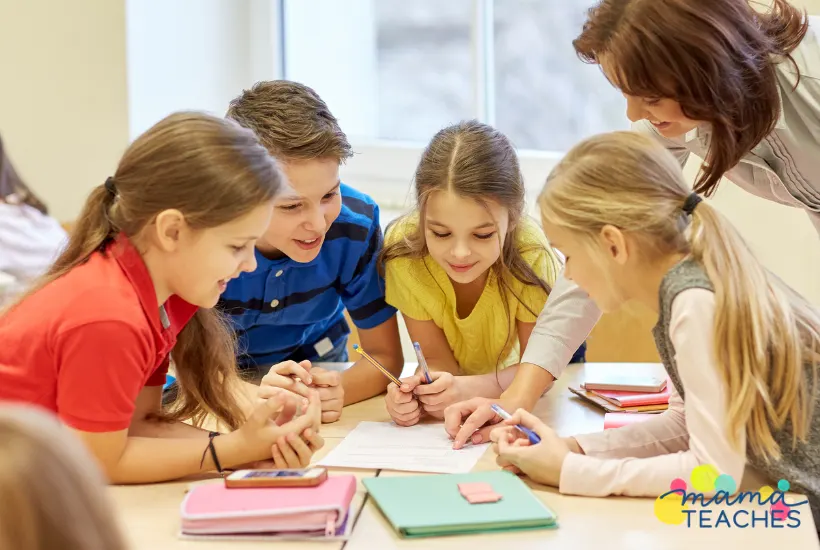
By teaching kids how to use a planner, we can lay the foundation for effective time management, organizational skills, and a sense of responsibility.
This article contains affiliate links to things that you might like.
Why Do Kids Need a Planner?
The use of a student planner is essential for kids because it improves organization, responsibility, and independence.
Planners also teach valuable time management skills, helping kids allocate time for tasks, set priorities for homework, and include moments for leisure and relaxation.
This control over their schedules reduces stress and keeps them focused and productive throughout the day.
In addition, student planners provide a designated space for setting goals, big and small, and offer a visual representation of progress and achievements.
Celebrating these milestones serves as motivation, encouraging kids to strive for even greater accomplishments.
Choosing the Right Planner for Your Kids
Choosing the right planner for your kids is essential to ensure they embrace organization and planning effectively.
Consider age-appropriate designs and themes that capture their interest.
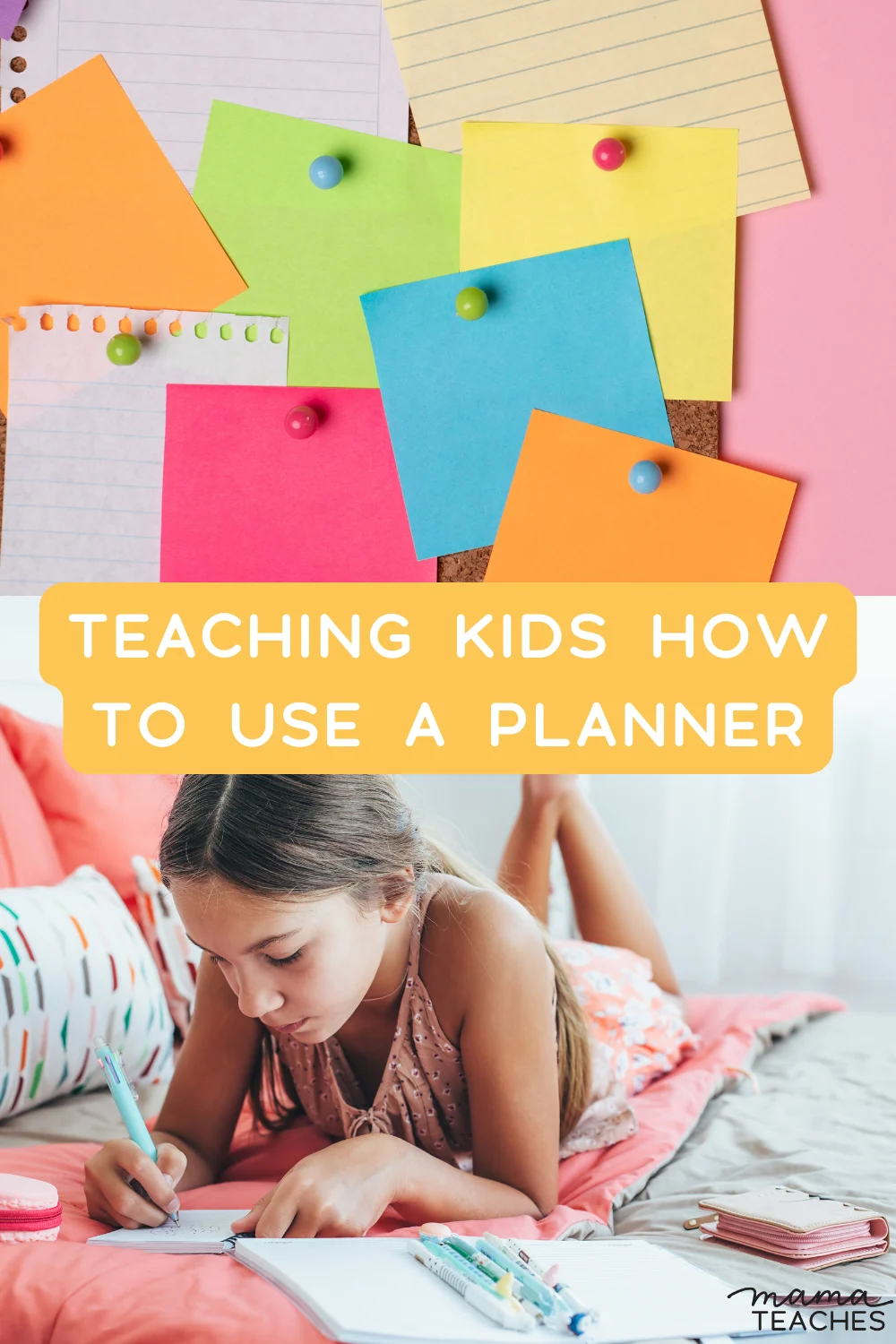
For younger children (ages 5-10), opt for playful and vibrant designs with fun characters, while older children (ages 11-13) may prefer more sophisticated student planner options with motivational quotes and abstract patterns.
A user-friendly layout is crucial for a planner to be effective. There are a few key features you should always look out for in a student planner.
Look for attractive visuals, intuitive navigation, and age-appropriate complexity.
Daily spreads work well for busy schedules, weekly spreads for balanced ones, and monthly spreads for long-term planning.
Start with the use of a weekly desk planner, so children have it on their desks at all times.
You can print it yourself on larger paper so the planner becomes a working mat as well.
If you have middle schoolers, you could choose a student planner instead to keep track of all their school work daily.
Involving your child in the decision-making process can make choosing a planner a fun and empowering experience.
Consider their preferences and interests, and let them personalize their planner with their favorite colors, themes, or hobbies.
By tailoring the planner to their liking, they’ll feel a sense of ownership and be more motivated to use it consistently.
Teaching Kids How to Use a Planner Effectively
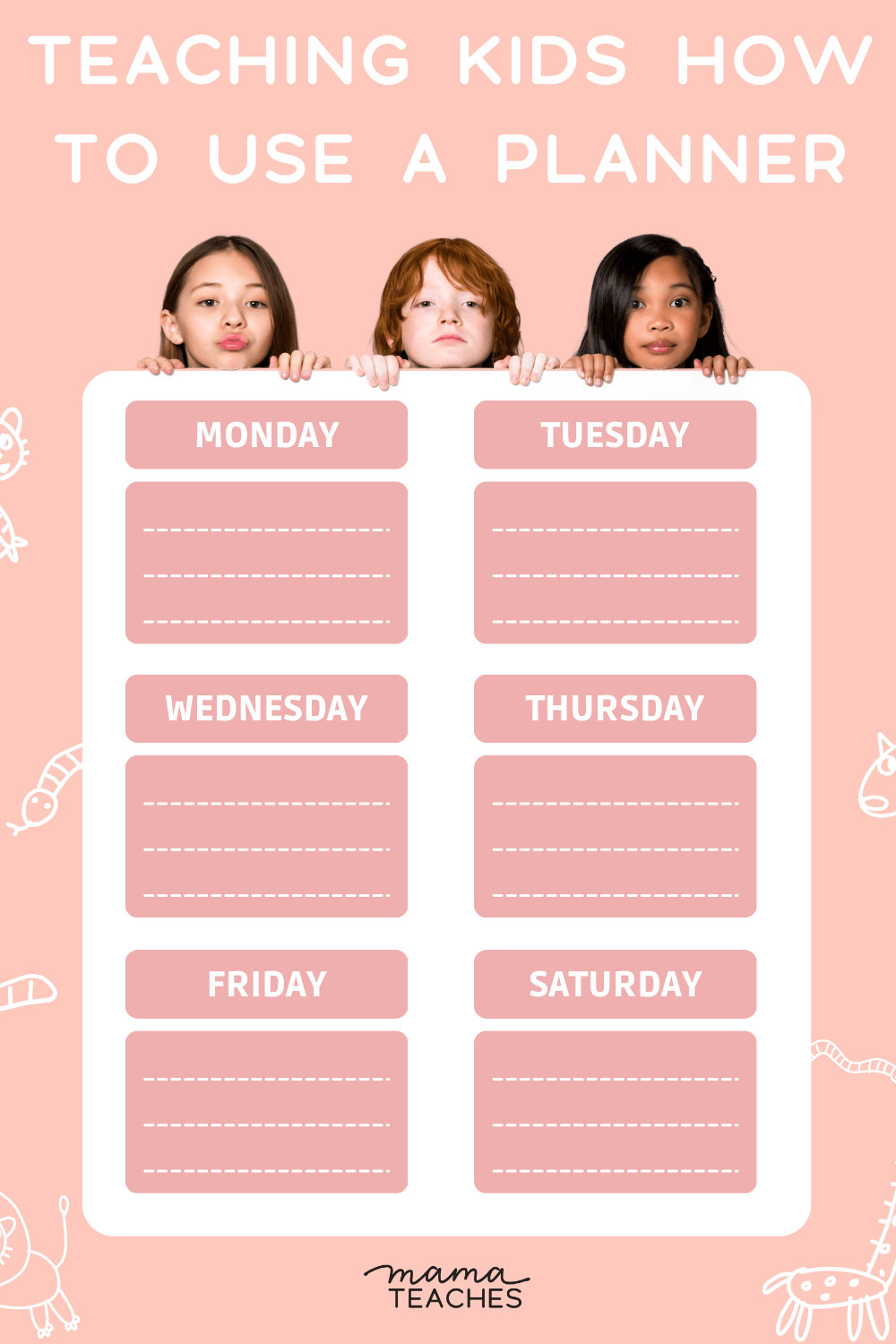
We tend to assume kids inherently know how to use a planner but the truth is using a planner effectively is a skill that takes modeling, guidance, and some trial and error.
So how can we teach kids the effective use of a planner? Maybe the most important way is to demonstrate this skill and lead by example.
Be a role model for effective planning by using your own planner regularly and showing them how your planner helps you stay organized and productive.
There are also other ways to help kids embrace planning:
Help Kids Set Up Their Planner
Setting up a new planner can be a bit overwhelming, especially for kids who have never used one before.
But don’t worry; you can make it a fun and engaging experience!
Sit down with your kids and show them how to use each section and feature of the planner.
Take the time to explain everything in a way they can understand. Remember, it’s all about helping them feel confident and excited about their new planner!
Plan with Them
Planning with your kids is a fantastic way to introduce them to the world of planners and make the process enjoyable.
Since they might be new to using planners, they’ll likely need some guidance at first.
You can take the lead and fill in the planner for them, or you can involve them in the process.
One approach is to be the scribe and fill in the planner while discussing each task or event with your kids.
This way, they actively participate and understand what you’re doing.
Another option is to give them prompts and let them fill in the planner themselves.
Encourage them to express their thoughts and ideas as they do it.
Alternatively, you can model how to use a section of the planner and then let them take charge of the rest.
Remember, there’s no right or wrong way to do this. The goal is to make planning fun and engaging for your kids while helping them become more familiar with using their new planner.
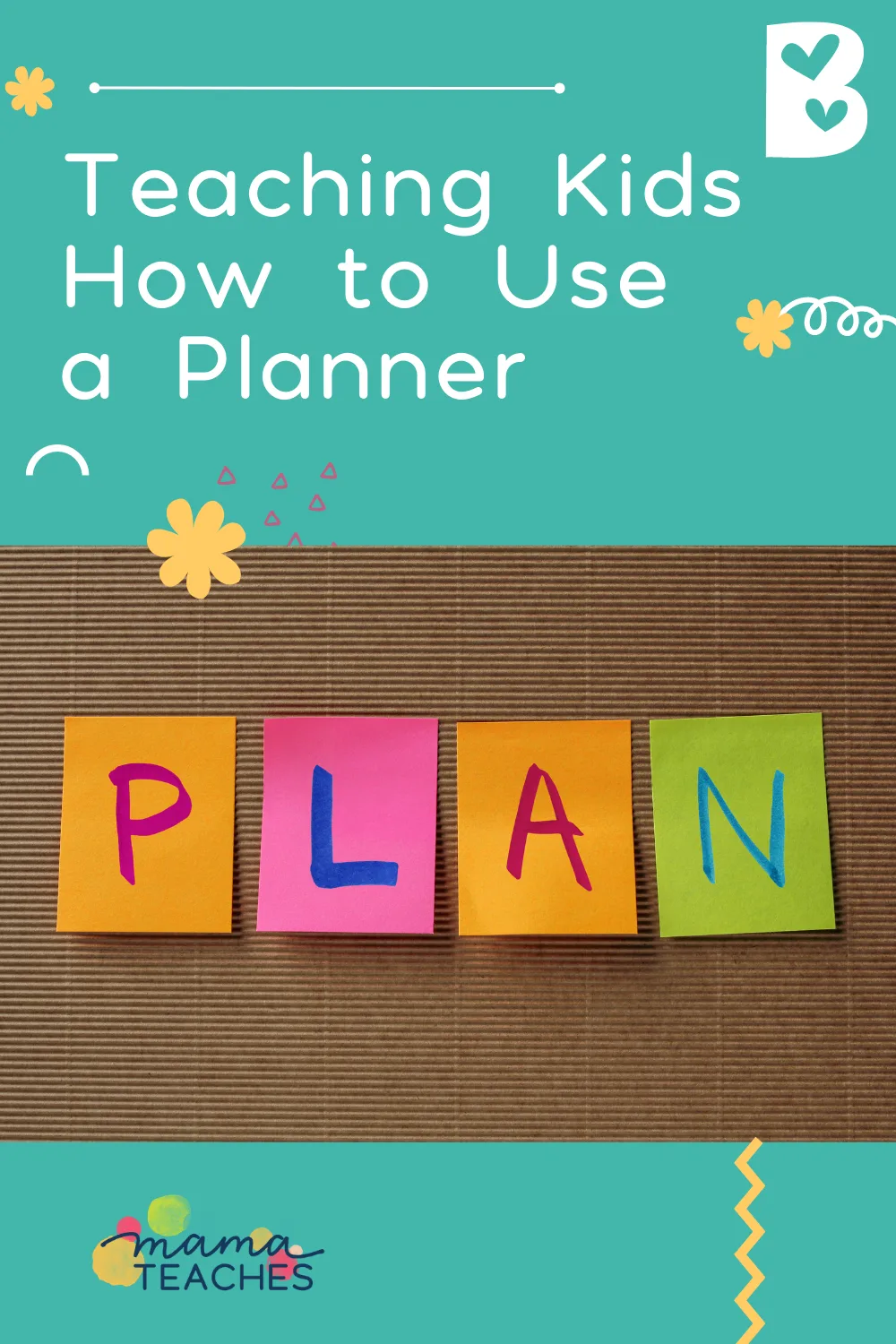
Use Color Coding When Planning
Color coding is a fantastic organizational technique that can make planning even more effective and visually appealing for kids.
If we use different colors for various areas of life or for different subjects, it becomes much easier to find and distinguish between tasks and activities.
To implement color coding with your kids’ planners, start by helping them choose a set of colored pens, markers, or highlighters.
Each color can represent a different subject, activity, or type of task.
For example, they can use blue for math assignments, green for science projects, and red for extracurricular activities.
Encourage your kids to get creative with their color choices and find combinations that work best for them.
The goal is to make the planner visually engaging and help them quickly identify tasks and events at a glance.
With color coding, your kids will not only have an organized and visually appealing planner, but they’ll also develop excellent organizational skills that can benefit them in many areas of their life.
So, let the colors flow and make planning a colorful and exciting experience!
Teach Kids to Use Various Supplies for Planning
Planning can be a fun and creative process, especially when kids have access to various supplies and stationery items.
Take this opportunity to introduce your kids to a world of organizational possibilities!
Start by showing them how to use tabs to mark important sections in their planner.
They can use tabs to quickly find their weekly schedules, monthly goals, or important dates.
Tabs help keep the planner neat and organized, preventing pages from getting wrinkled or torn.
Next, teach them about the magic of sticky notes.
Sticky notes are excellent tools for jotting down quick reminders, important dates, or even motivational quotes.
They can easily move sticky notes around to rearrange tasks or events, making planning a flexible and adaptable process.
Introduce them to the wonderful world of washi tape, which comes in various colors and patterns.
Washi tape is perfect for adding a touch of creativity to their planner.
They can use it to highlight special events, divide sections, or create borders for their pages.
The possibilities are endless, and it brings an element of fun and personalization to their planning journey.
Highlighters are essential tools for color coding, as we mentioned earlier.
Demonstrate how to use highlighters to mark different subjects or categories.
For instance, they can use one color for school assignments, another for extracurricular activities, and so on.
Highlighters make it easy to spot important tasks and create a visually appealing planner.
Make Using a Planner a Daily Routine
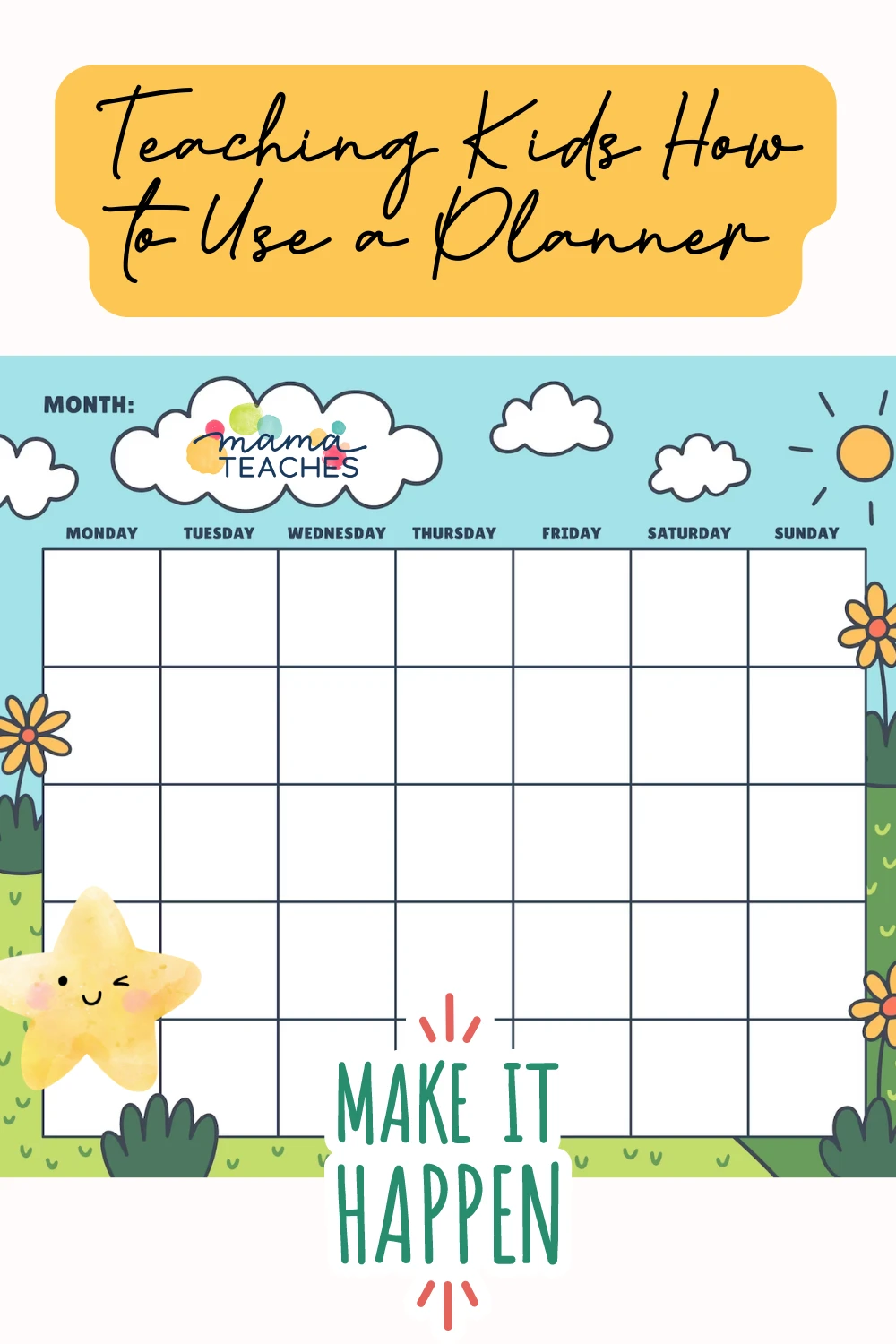
Creating a daily planner routine is essential for making planning a natural part of your child’s day.
Just like you teach them the time or how to read a calendar, set aside a specific time each day for updating and reviewing their planner.
Consistency is key to forming this valuable habit.
Choose a time that works best for your child’s schedule and make it a daily ritual.
It could be right after breakfast, before starting schoolwork, or after dinner.
Having a designated planner time ensures that they allocate time for their planner amidst their other activities.
While establishing this routine, remember that keeping a planner is a new concept for kids, and they might need gentle reminders.
Be there to guide and support them. Remind them to take out their planner and update it with their tasks and assignments.
You can make it fun by setting a reminder on your phone or using a fun alarm sound.
Encourage your child to make their planner part of their daily checklist.
Just like they remember to brush their teeth or pack their school bag, checking their planner should become a natural part of their routine.
With gentle reminders and positive reinforcement, using the planner will soon become a habit they don’t want to miss.
Also, be sure to celebrate their efforts in using their planner regularly.
Praise them for their organizational skills and how their planner helps them stay on top of things.
Positive reinforcement goes a long way in motivating kids to continue with their planner routine.
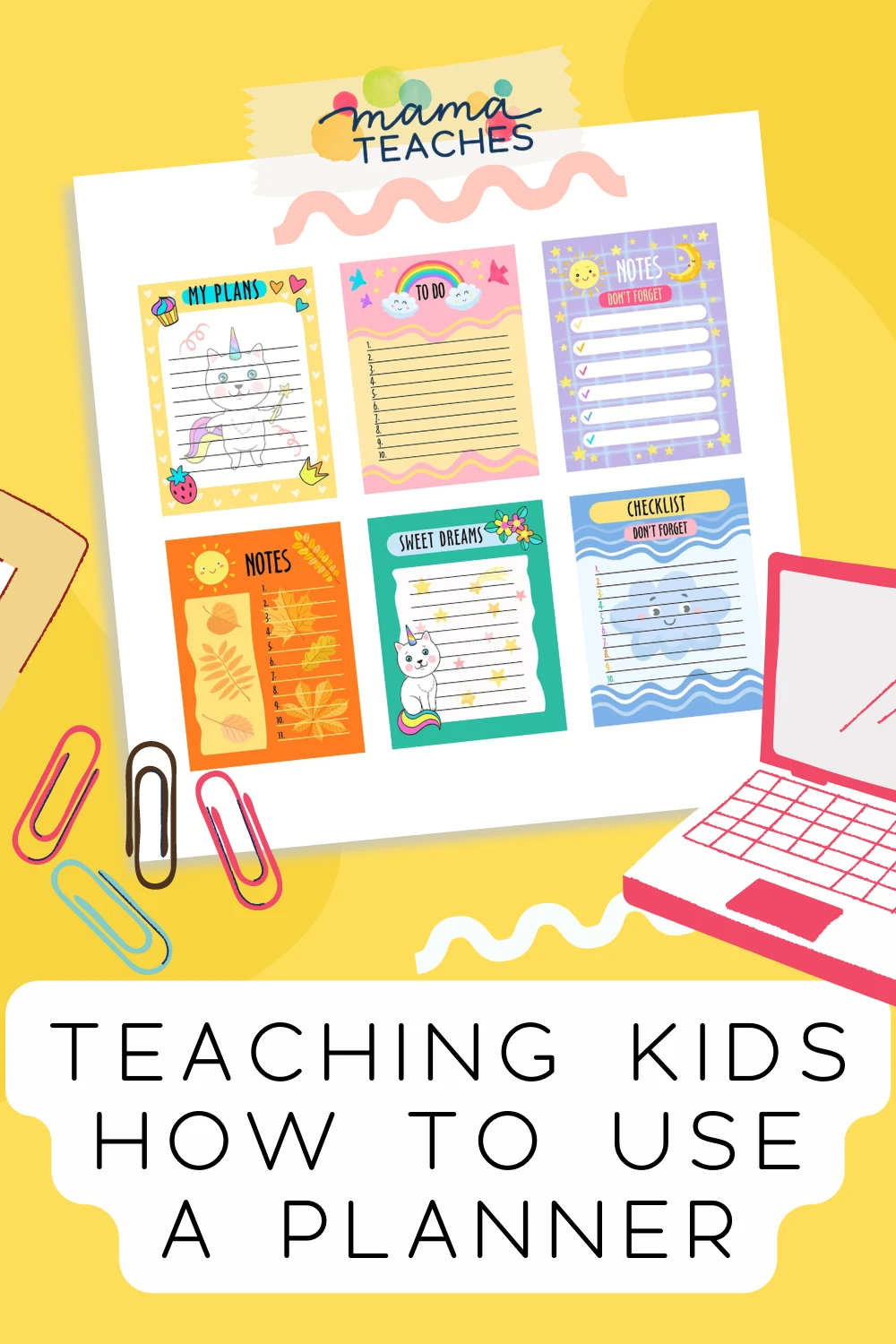
Address Any Planning Challenges
Planning and staying organized can be a new and sometimes challenging concept for children, so it’s important to be available to support and guide them along the way.
If your child gets stuck or feels overwhelmed with using their planner, be patient and offer gentle guidance.
Encourage them to express their concerns or difficulties and listen attentively to understand their perspective.
Assure them that it’s okay to make mistakes and that learning to use a planner effectively takes time.
Help them break tasks into smaller, manageable steps, just like they would with their school assignments.
For example, if they find it challenging to prioritize tasks in their planner, work together to identify the most important tasks for the day and list them first.
Show them how to use color coding or stickers to visually distinguish between different types of activities or subjects.
If they are struggling to keep up with their planner routine, offer reminders and encouragement.
Remind them of the benefits of using a planner, such as being more organized and reducing stress.
Celebrate their efforts, no matter how small, to keep them motivated and engaged.
Encourage them to ask questions and seek your guidance whenever they need it.
Be their planner buddy and share your own experiences of how planning has helped you stay organized and productive.
Your support and involvement will make the process more enjoyable and less intimidating for them.
Remember, every child is unique. Some kids may take to using a planner quickly, while others may need more time and practice.
Be patient, and don’t be discouraged if they don’t fully embrace the planner right away.
With your gentle guidance and consistent encouragement, they will gradually develop the skills and confidence to use their planner effectively.
Lastly, celebrate their progress and accomplishments along the way.
Every step they take towards becoming better planners is a success worth acknowledging.
Teaching your child how to use a planner effectively is a journey, and with your support, they will gain valuable life skills that will benefit them in the long run.

Foster Independence
Encouraging kids to take ownership of their planners and experiment with various planning strategies empowers them to become more independent and responsible individuals.
When children are given the freedom to manage their planners, they are presented with the opportunity to make decisions on how to structure their schedules, prioritize tasks, and allocate time effectively.
This process develops their critical thinking skills, problem-solving abilities, and adaptability in choosing what works best for their unique needs.
Moreover, allowing kids to explore different planning methods helps them develop essential time management and self-regulation skills.
They gain a deeper understanding of setting realistic goals, creating a balanced schedule that accommodates both academic and personal activities.
As a result, children become more disciplined and focused, taking responsibility for managing their own lives.
Through this process of experimenting and personalizing their planners, children also learn the value of accountability and responsibility.
They begin to recognize the consequences of their planning decisions, whether it’s completing tasks on time or making time for their hobbies and passions.
By taking ownership of their planners, children become more invested in their daily routines and are motivated to follow through with their plans.
Furthermore, fostering independence in planning instills a sense of confidence and self-assurance in children.
As they see the positive results of their planning efforts, their self-esteem grows, and they develop a belief in their ability to take charge of their lives and achieve their goals.
Reassess Before Getting Another Planner
Before rushing to get another planner, it’s essential to take a moment to reassess and reflect on the current one.
Choosing the right type of planner often involves some trial and error, especially for kids who are still figuring out their preferences and planning style.
By involving them in the process of evaluating their current planner, you can guide them in making informed decisions for their next one.
Encourage your kids to look back at their old planners and identify the sections or features they used most frequently.
Ask them what aspects of the planner made the most sense to them and how those elements contributed to their planning experience.
This reflection allows them to recognize what worked well for them and what might need improvement.
Additionally, inquire if there were any challenges they faced while using the planner.
Were there any sections they rarely used or were there elements that didn’t align with their needs?
This kind of feedback helps them understand their planning habits and preferences better.
Based on their assessment, discuss potential changes or adjustments they would like to see in their next planner.
Perhaps they’d like more writing space, different layouts, or additional features that cater to their evolving needs.
This process empowers them to actively participate in the planning journey and personalize their planners according to what suits them best.
Remember, choosing a planner is not a one-size-fits-all decision. Each child has unique preferences and requirements when it comes to organization and planning.
By involving them in this reevaluation process, you foster a sense of ownership and accountability, making them more invested in the planning process.
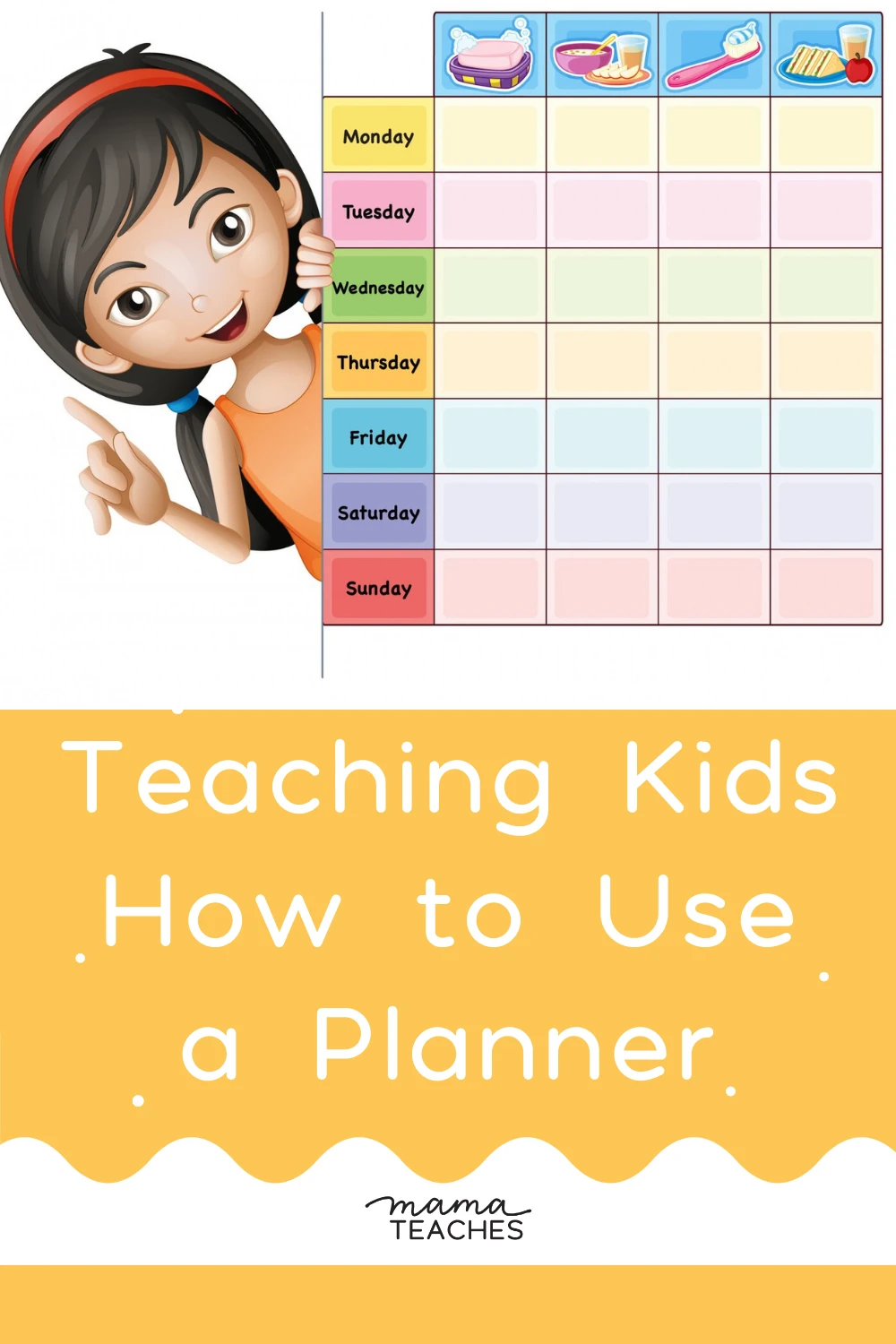
10 Long-Term Benefits of Using a Kids Planner
Encouraging kids to use a planner extends far beyond simply organizing daily tasks.
The consistent practice of planning offers many more long-term benefits that positively impact their lives.
Cultivating Organizational Skills
As they regularly use a planner, kids discover the art of efficient time management, prioritizing tasks, and effectively allocating their resources.
These essential skills form the backbone of their journey to planning success, empowering them to confidently take on ever more challenging academic and personal responsibilities.
Building Time Management Proficiency
With a planner as their trusty guide, kids develop proficiency in time management.
By setting realistic goals and diligently adhering to deadlines, they grasp the importance of pacing themselves and gracefully steer clear of last-minute rushes. T
Nurturing Responsibility and Accountability
By allowing kids to take ownership of their planners, we instill a sense of responsibility and accountability.
Empowered by the knowledge that they are in charge of their time and responsibilities, kids grow more confident in navigating life’s challenges and taking charge of their own journey.
Developing a Growth Mindset
By embracing planning as a regular practice, kids cultivate a growth mindset that fuels their journey of progress and improvement.
They come to understand that effort and perseverance are the keys to unlocking their potential.
This will translate into a positive approach to challenges, where they view obstacles as opportunities for growth.
They can also develop the resilience and determination to overcome hurdles and achieve their goals.
Enhancing Academic Performance
Planning supports academic success by ensuring that kids stay on top of assignments, study for exams in a structured manner, and manage extracurricular activities effectively.
Through effective planning, kids develop a sense of control over their academic journey, reducing stress and anxiety.
Fostering Discipline and Consistency
Consistently using a planner cultivates discipline in children.
They learn to follow through with their plans and create routines that foster consistency and productivity.
Managing Stress and Anxiety
Planning helps reduce stress and anxiety by providing a clear roadmap for tackling tasks.
Kids feel more in control of their responsibilities, allowing them to approach challenges with confidence.
Forming Lifelong Habits
Planning becomes a lifelong habit that extends well beyond childhood.
As kids grow into teens and adults, they carry these invaluable organizational skills into their academic pursuits, professional careers, and personal lives.
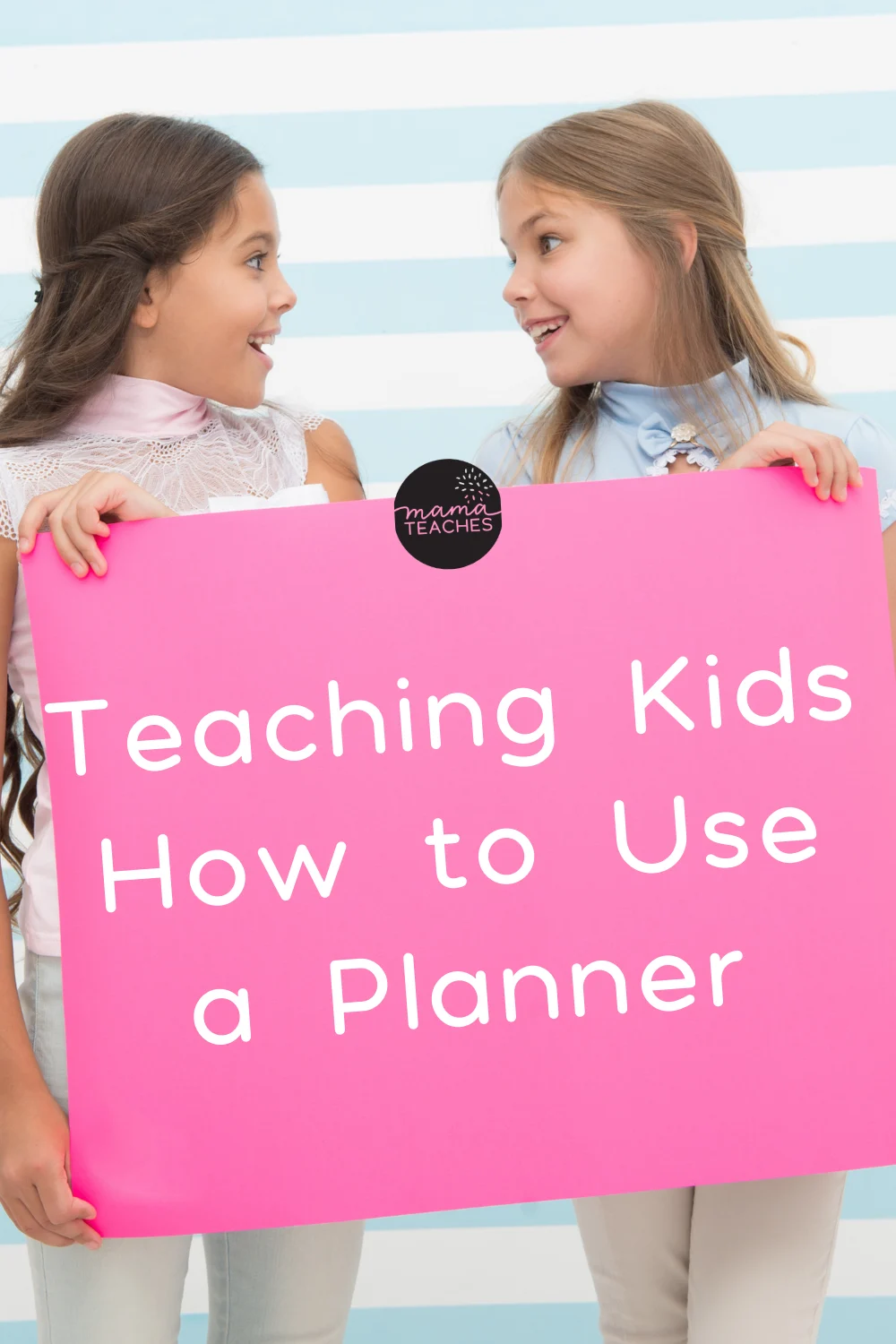
Improving Decision-Making Skills
Through planning, kids learn to make informed decisions about how to best allocate their time and resources.
This ability to prioritize and make strategic choices lays a foundation for sound decision-making in the future.
Boosting Self-Esteem and Confidence
Successfully using a planner allows kids to see the tangible results of their efforts.
As they accomplish their goals and witness their progress, their self-esteem and confidence grow.
Final Thoughts
Introducing kids to the world of planners can have a profound impact on their lives.
Beyond just organizing daily tasks, using a planner fosters essential life skills and positive habits that extend well into adulthood.
By embracing planning as a regular practice, kids develop proficiency in time management, organizational skills, and a growth mindset.
They become more responsible and accountable for their actions, leading to a greater sense of independence and self-reliance.
But teaching kids how to use a planner effectively is a journey that requires patience and encouragement.
By involving them in the process of choosing the right planner and guiding them through its usage, parents can make planning a fun and empowering experience.
With time, they will develop their planning style, experiment with different techniques, and ultimately form lifelong habits that set them up for success in all aspects of life.
ABOUT THE AUTHOR
Laura is a homeschool mom and photographer from Europe, running the Monkey And Mom homeschool blog. With eight years of experience homeschooling her gifted son, Marc, she shares her discoveries and ideas to inspire other homeschool parents.
